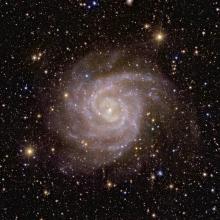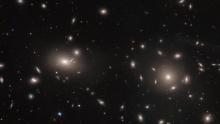Listen to today's episode of StarDate on the web the same day it airs in high-quality streaming audio without any extra ads or announcements. Choose a $8 one-month pass, or listen every day for a year for just $30.
You are here
Massive Milky Way
The Milky Way is beginning its journey into summer’s evening skies. It arcs low across the east as night falls. It’s anchored by teapot-shaped Sagittarius in the south, the graceful swan in the east, and W-shaped Cassiopeia in the north. It climbs higher during the night, and passes directly overhead in the wee hours of the morning.
That hazy band of light outlines the disk of the Milky Way galaxy. The disk contains hundreds of billions of stars, plus giant clouds of gas and dust.
Yet most of what makes up the Milky Way is dark matter. It emits no detectable energy. But it reveals its presence by tugging at the visible matter. And a team of astronomers recently used that tug to measure the mass of the Milky Way: 1.5 trillion times the mass of the Sun — one of the most impressive galaxies around.
The study used observations from two space telescopes, Gaia and Hubble. They measured the motions of globular clusters — densely packed balls of hundreds of thousands of stars. The clusters form a vast “halo” around the galaxy’s center. The halo extends far beyond the Milky Way’s disk, into a region that’s dominated by dark matter. How fast the clusters move depends on the combined mass of the dark matter and visible matter.
The telescopes provide the best measurements of the motions of the clusters to date. Because of that, the astronomers say their study also should provide the best measurement of the Milky Way’s mass.





